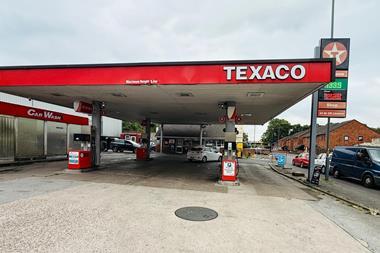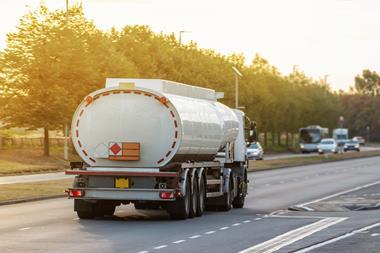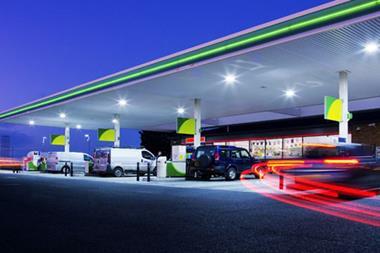There are two good reasons why forecourt operators need to take their wet-stock management seriously safety and the environment; and because it makes good business sense. So says Tokheim marketing manager, David MacHale.
He explains: "Responsible petrol retailers are conscious of their safety and environmental obligations when it comes to the storage of petrol, diesel and gas. Fuel spillages put the environment and people’s safety at risk, so it is paramount that petrol retailers have a system in place that ensures constant monitoring of fuel to reduce the chances of spillages or leaks. Stricter regulations, increasing inspections, and tougher penalties, are leading to a rise in the cost of compliance.
"In recent times, forecourts have been closed and fined due to sub-standard monitoring of fuel, and the recent oil spill in the Gulf of Mexico has put a spotlight on safety in the petrol-retailing sector."
He continues: "Wet-stock solutions help increase control over site inventory and deliveries so you know exactly how much fuel you receive in every delivery. They prevent truck haul-backs and site run-outs up-to-the-minute information lets you know exactly how much fuel is required or is remaining in your tanks."
Tokheim has recently completed work on Maxol’s Super Service Station in County Cork, Ireland. It supplied and configured a number of wet-stock management solutions including its Fuel POS plus a tank level gauge system. The package helps ensure that wet-stock inventory is managed efficiently and that the service station complies with the latest environmental legislation. A two-lane FuelPOS system maximises the stock levels of FMCG items in the store as well as ensuring fuel levels are expertly optimised in the tanks.
Intelligent data
At Fairbanks, the ibank service uses an intelligent data processor installed behind the counter to collect stock levels and temperature from the tank gauge before and after each sales transaction. This data is sent back to the Fairbanks office via broadband throughout the day. The company says the first benefit is the vast reduction in human involvement and also the speed with which the data is received in hours rather than days or weeks. Collecting data so quickly allows every operator to read stock levels ’live’ either on Fairbanks’ website or on an internet-enabled mobile phone. So checking when you need that next delivery doesn’t mean calling into each of your sites.
Over the past 18 months Fairbanks has been busy rolling out the ibank service to over 1,100 forecourts (half of its customer base) including all BP and MRH sites. As a result, the number of wet-stock investigations has increased as the extra data collected highlights new issues. Real-time data allows issues to be pin-pointed and acted on much sooner than SIR (statistical inventory reconciliation) alone, as data for each pump can be analysed separately.
David Charman of Parkfoot Garage in West Malling, Kent uses ibank. He says: "My site manager recently took a call from Fairbanks telling us that they had detected a sudden fault on one of my diesel pumps which had started dispensing twice the amount of measured fuel. We immediately locked off the nozzle and put a call out to our pump service contractor. Because of the ibanks’ service, they were able to confirm exactly what time the fault occurred. We found out it was due to a faulty pulsar. Within hours of the pump being repaired we contacted Fairbanks and they came out and checked and re-stamped the meter and put it back in use. So what would have taken weeks to identify in the past was resolved in just three days."
Fairbanks also offers the ivan service. This vehicle can perform pump meter audits without the need for manual handling by storing the measured fuel on board until the tanks are ready to be emptied at the fill-points. The company says this means the time on site can be significantly reduced and disruption kept to a minimum.
Gilbarco Veeder-Root (GVR) has created a new wet-stock management business unit which it says combines the power of the Veeder-Root and Fafnir tank gauge brands with the analytical skills and customer support of its fuel management services team.
Based in the UK but covering the Western European and Russian region, the new business unit is headed by managing director Patrick Forsythe.
"Customers right across the UK and Europe are asking for support in areas of calibration, loss analysis and more recently theft detection. Fuel theft is becoming a bigger issue as prices rise," says Forsythe.
"Fuel quality is also a closely associated issue. In particular the effect of microbial growth in biodiesel and phase separation in ethanol fuels is impacting retailers right across Europe, reducing flow rate at the nozzle and increasing maintenance costs.
To help with fuel quality in general, we have introduced density measurement capability to a high degree of accuracy, and we are currently field testing new technologies with UK customers to detect phase separation emulsions in storage tanks."
Meanwhile Phil Maud, managing director of the forecourt services division at Brulines, says his company offers solutions to ensure that every litre that a forecourt operator buys from his supplier contributes to his return on capital.
"Fuel is ’lost’ in many ways over-dispensing nozzles are the major concern easily costing thousands of pounds a year. There are also short or hot product deliveries and gauge errors," he says.
"Losing fuel can also be about theft internal and external, and again real-time analysis can highlight issues much quicker. One of the most worrying trends we are seeing at the moment is the number of overnight thefts of thousands of litres from tanks on closed forecourts. Because our service runs 24 hours a day, seven days a week, we can spot this happening in real-time and alert customers, security companies, and even law enforcement, right through the night.
Maud reckons many forecourt operators have spent a lot of money on new epos and gauges but are not using them to their full potential to manage their wet stock effectively.
"If you haven’t got a gauge get one," he advises. "But you don’t need all the bells and whistles touchscreens, printers etc. Too many sites have bought all these things and the staff don’t know how to use them. What is the point of hundreds of different alarms if staff just press the ’alarm off’ button? Only a dedicated remote monitoring technician, supported by intelligent real-time trend analysis is going to react rapidly to an alarm, assess the issue and then react accordingly."
Maud reckons that biofuels bring a whole new challenge to wet-stock management: "Not only are they more corrosive and therefore increase the risk of leaks as they damage joints and seals, but ethanol in unleaded is prone to holding water in suspension. Over time, phase separation can occur, which means the water/ethanol mixture separates out and collects at the bottom of the tank. This can happen very suddenly resulting in customer vehicle breakdowns and significant costs for the retailer.
"Density monitoring is probably the next big thing in assisting in managing fuel stocks and helping identify issues such as potential phase separation, contamination and fuel delivery crossovers. Just this month the first site in the UK will open with density sensors fitted as standard on all tanks. Currently only OPW gauges, which Brulines supplies to the UK market, can offer this as an integrated solution. Again, measuring density on its own is not enough. You need to look at real time data and very quickly identify trends in the figures to alert you to a potential issue before it causes problems.
"Also, wet-stock management is not just about managing fuel as a liquid. Every time a delivery occurs around 0.2% of the delivery is lost back into the tanker. VR2 can further increase these losses. We see vapour refining solutions that collect these vapours and convert them back into liquid fuel as having the potential to reduce losses significantly."
Meanwhile, according to Rodney Carter, managing director of Petroman Environmental Services, the fundamentals of wet-stock management are: tank capacities; fuel-stocking levels; pump-meter settings; Stage 2 balance metering; and tank gauges.
"Controlling the stock levels in tanks will enable you to maintain the vapour and reduce wet-stock losses. You always need to keep a tight control on dispenser variances and be aware of the gauge readings and their characteristics.
"You also need to ask yourself whether the losses are greater with full or empty tanks? Then you need to set targets relative to present losses. For example, reducing losses of 0.4% down to 0.3% or 0.3% down to 0.2% or, for the really enthusiastic, down to 0.05%. All of these targets are achievable providing you carry out a true assessment of your site and are prepared to invest to get the rewards."
Carter says other questions to ask are:
Where is my product supplied from a cold terminal or a warmer refinery?
What is my storage tank capacity? Are the tanks nearly full after a delivery?
Are my gauges consistent across the range of the tank capacities eg do I lose lots of stock after deliveries and gain it between deliveries?
When did I last have the meters checked and adjusted? Study the reports.
"Once this work has been done, carefully monitor the results over an extended period as losses do vary throughout the year. The extent of your expectation is dependent upon the volume of sales. A sales throughput of below 3mlpa limits the return, but is still worthy of investment. Sales throughput above 3mlpa means the return on investment is possible.
"Above 3mlpa means the introduction of Stage 2, which again can increase the return on investment. If you have sales throughput of over 4mlpa then you can achieve very low losses of below 0.07 % and better, making the investment even more worthwhile."
Case study:
"In operating nearly 300 filling stations we experience a greater likelihood than many that we will have a tank or line leak. One could view this as an acceptable risk of being in an industry where, for many years, fuel has been stored underground in containers and pipe work that will corrode over time. As we all know, the cost of the lost product is not the biggest cost in having a leak.
"The ground remediation costs can easily run into six figures if the leak is of sufficient magnitude or goes undetected for an extended period. We find the key to reducing this risk is to have monitoring systems in place that will quickly identify any such problems and allow us to resolve them before we have lost any significant volume of product.
"MRH has implemented Fairbanks’ ibank service across its whole estate and this has resulted in the timely identification of a number of tank and line leaks many before there was any product lost to ground. In addition to this, the system has identified where we could be giving away our profits through over-dispensing fuel."
Case study
"I knew the time had come to consider a third-party wet stock management system linked to electronic tank gauges when I was standing on one of my forecourts in the pouring rain trying to write the diesel dips on a soggy piece of paper.
"The pen wouldn’t write, I was soaking wet and I smelt of fuel. Later that day, when I realised I had gained about 1,000 litres of diesel, I decided to re-dip the tanks. I repeated this exercise every day for a week or so before it dawned on me that my diesel gain was because the dip stick had broken off a couple of inches.
"From that experience I’ve never looked back. I took a leap of faith and installed tank gauges at all our sites.
"Gauges installed and working, I then decided to monitor our wet stock on a more ’professional’ regular basis.
"We had made several attempts at using the wet-stock systems supplied with our back office software but they always depend on my daughter Emma or me having the time to enter the relevant data.
"It never seemed a priority. However, we always knew how many cans of Coke or Mars bars we should have had in stock. The petrol was underground so we never saw it and it didn’t seem to matter as much. That was all in past things have changed.
"I have upgraded all the sites’ fuel gauges to TLS 350R and one of the best service investments I have made has been to subscribe to Fairbanks and allow them to monitor and report on all aspects of our wet-stock management. Regular as clockwork I receive the reports via email and these are forwarded to the relevant sites to be stored.
"Visits and inspections of our wet-stock records by the local petroleum officer are no longer an issue and I even feel proud to be able to present them with a comprehensive and professional analysis of our wet-stock reconciliation.
"I only wish I understood the reports, but my daughter does so that’s okay!"
The Blue Book
The ’Blue Book’ as it has become known, is widely accepted as the petrol retailing industry’s definitive guide to design, construction, maintenance and decommissioning of filling stations. It is due to be released in its third edition later this year.
In this latest revision, Section 11 which covers leak containment and leak detection systems is brought up to date with the latest innovations and advancements. The guide aims to raise standards of health and safety and environmental protection by explaining the options available to site operators dependent on the level of risk and the type of tank and pipework installation.
SIR-based remote monitoring is compared with alternatives such as automated alarms from tank gauges and real-time analysis makes an appearance. Site operators and petroleum regulators can follow the step-by-step process to determine the best and most cost-effective solution. A copy of the guide can be purchased from the Energy Institute or APEA.
Case study
Bill Wragg is wet-stock management consultant to MPK Garages. He explains their routines: "Every site does daily monitoring and the figures are sent to head office. They are then checked externally several times a month. Analysis is produced at the end of the month. If we have any doubts if variances are outside the norm, for example we mount an immediate site investigation. This takes into account things like problems with administration, gauges and deliveries. Checks on pumps and nozzles are also done as part of routine inspections to see how much they are under or over measuring. We use approved verifiers to re-check pumps, adjust and re-seal them. During the measuring checks, the pump panels are removed so we can check seals for leaks because leaks can cause environmental pollution."


























No comments yet